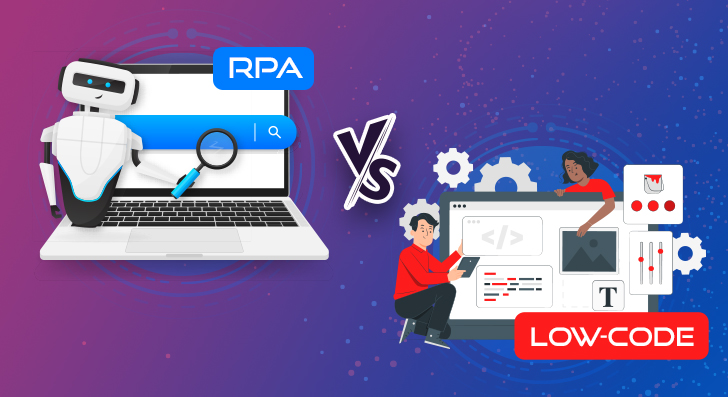As per a global survey by Automation Anywhere, the average employee spends around 3 hours each day (60 hours each month) on tasks that can be easily automated- entering data, compiling reports, or filing documents-instead of focusing on strategic, revenue-generating tasks. Workflow automation can replace these manual activities with digital alternatives, helping organizations work smarter and thrive in a fast-paced world. By streamlining mundane tasks, process automation optimizes operational costs and boosts workforce efficiency.

The marketplace is inundated with tools and technologies that can help businesses implement process automation, low-code, and RPA being the most popular ones. In this blog, we will dive deep into the benefits, limitations, and use cases of both to help decision-makers understand which technology best aligns with their requirements.
Robotic Process Automation (RPA): Drive Productivity with Software Robots
RPA or Robotic Process Automation utilizes software robots to automate rule-based, repetitive tasks. These bots can be programmed to mimic human interactions with software systems, which means they can easily perform activities such as logging into applications, extracting structured or semi-structured data from documents, moving data between siloed applications, filling out forms, scraping information from websites, and more.
Mostly used across back-office applications, RPA enables automation of mundane, clerical tasks that take up a lot of time but don’t add much value. With a suitable RPA solution in place, employees can free up time to focus on high-impact, strategic work. No wonder, RPA has been implemented in verticals as diverse as manufacturing, healthcare, financial services, legal, compliance, operations, customer support, and IT.
Implemented the right way, RPA can help businesses realize an array of benefits including:
| Reduced Costs | Organizations can replace hundreds of human workers performing mundane, repetitive work with software robots programmed for a specific task that can do the work faster and with fewer to no errors. |
| Enhanced Scalability | Bots are akin to a 24-hour digital workforce, as they can work round-the-clock and be deployed on-demand. As a result, businesses can seamlessly scale up or down depending on their needs. |
| Hassle-Free Implementation | RPA can be integrated into any kind of digital infrastructure, without the need for investments in custom software or in-depth integration. |
| Stronger ROI | RPA is noninvasive and does not require changes to the existing application, eliminating the need for large-scale change. This ensures a quick ROI for RPA-based projects. |
Notwithstanding the aforementioned benefits, RPA is no silver bullet-it comes with its own set of limitations, some of which are as follows:
| Subsequent Changes Lead to Broken Processes | RPA bots are trained to follow very specific actions; even minor changes to the existing UI can cause the process to fail. Anything happening beyond the scope of pre-defined procedures may confuse the bots, necessitating a complete re-tuning. |
| High Maintenance | RPA entails integration with the existing IT infrastructure, adding a layer of architectural complexity. This means the IT personnel in the organization have to ensure the deployed bots work as they are expected to while not adversely affecting any other IT process. |
| Focus Away from Strategic Projects | Used primarily for tactical gains, RPA may divert your attention away from strategic initiatives e.g. building new systems to support critical processes or replacing age-old systems that hold back organizational growth. |
| Cannot Interpret Unstructured Data | RPA is useful only for rule-based processes with well-defined criteria and structured or semi-structured data conforming to a data model. Many organizations have unstructured data including images, multi-media, or text that demand a higher degree of intelligence. |
Low-Code: Fuel Transformation with Visual Development Tools
A visual approach to software development, low-code aims at expediting the creation of customized business applications. Low-code platforms provide a rapid development environment with visual interfaces, drag-and-drop components, and pre-built templates that enable developers and non-developers alike to transform their business ideas into high-performing applications; the latter can replace cumbersome manual workflows and legacy systems. Equipped with powerful features for workflow automation and data integration, low-code development platforms are widely used for automating manual tasks, simplifying complex workflows, and streamlining end-to-end processes.
So, instead of simply automating a specific task within a process, businesses can overhaul the entire process and implement end-to-end digitalization with low-code.
RPA vs Low-Code: What to Use When?
When it comes to choosing between RPA and low-code for process automation, it is vital that you understand the specific capabilities, use cases, and limitations of each technology.
| RPA | Low-Code |
|---|---|
| Suited for automating repetitive, rule-based tasks within business processes | Ideal for rapid application development and workflow automation; addresses a broad range of business needs |
| Requires a specialized team with automation and scripting expertise | Requires minimal coding skills; encourages participation from both business and IT users |
| Automation may involve legacy systems with limited or no APIs or database access | Integration with legacy systems or complex workflows may be challenging |
| Scalability can be limited, as adding or managing multiple bots often requires additional configurations | More scalable, as applications can be easily modified and adapted to accommodate growing needs |
| Works great when an organization wants to realize quick efficiency and ROI gains | Perfect for scenarios where an organization needs to build prototypes to validate new ideas or concepts |
| Less flexible, primarily suited for automating individual tasks within specific applications. Adapting them to new processes may require significant reconfiguration | Highly flexible, allowing you to build custom applications and automate diverse processes across departments |
Complementing RPA with Low-Code: The Best of Both Worlds
In several scenarios, businesses should use a combination of both RPA and low-code instead of choosing between the two technologies. When automating business processes, RPA can be leveraged to handle repetitive, rule-based tasks whereas low-code can be used to develop user interfaces and custom applications to transform the overall process. This way, businesses can harmoniously blend the two technologies to get the best of both worlds and build a comprehensive, end-to-end automation solution.
For instance, in the customer service department, while RPA can be used to handle data retrieval, low-code can be used to enable hassle-free customer interactions by building user-friendly interfaces and applications.
Supercharge Business Efficiency with Low-Code
RPA vs Low-Code: The Final Verdict
Choosing between RPA and low-code eventually boils down to what your business objectives are. Perfect for automating rule-based, repetitive tasks, RPA is an ideal choice when you prioritize quick efficiency gains or when you are working with legacy systems that lack modern APIs.
In contrast, low-code is suited for building custom applications or complex workflows with an emphasis on user experience and adaptability. All in all, your decision should be based on the nature of the processes targeted and your specific integration requirements, with the possibility of using both for end-to-end automation.





